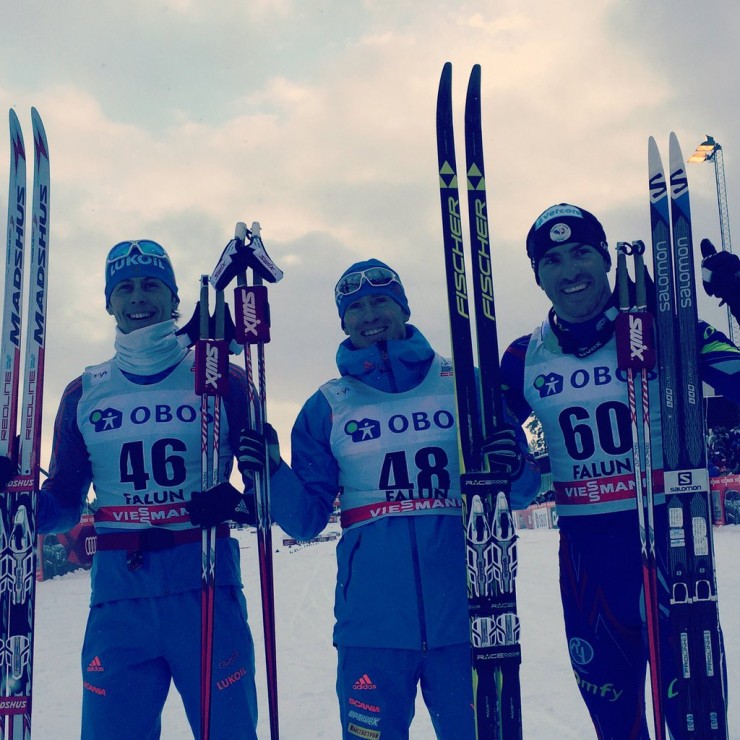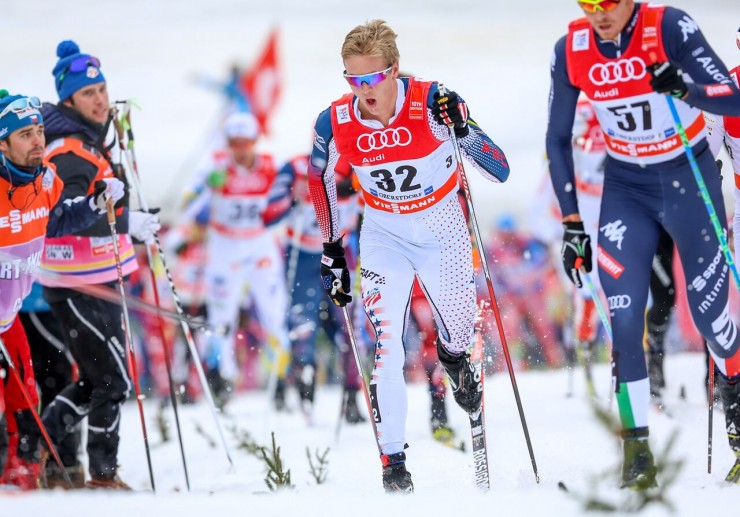
There were a few striking anomalies at the World Cup on Saturday in Falun, Sweden. First, there’s the race format. The men skied a 10-kilometer classic race. Excluding tours, it’s the first time a 10 k classic has run as a regular World Cup event since February 2003. Second, Saturday’s results found Norway locked out of the podium.
Russia secured the two top spots. Maxim Vylegzhanin took first in 25:14.6, Alexander Bessmertnykh was second (+3.5). France’s Maurice Manificat, only a sliver out of second, finished third (+3.6). With four skiers in the top 10, Russia seemed resurgent. Beyond the top-two positions, Sergey Turyshev placed seventh, 19.8 seconds back, with Sergey Ustiugov in 10th (+22.5).
Norway also put four in the top 10, with 24-four-year old Emil Iversen in fourth (+7.8), Martin Johnsrud Sundby in fifth (+9.5), Didrik Tønseth in sixth (+19.2), Niklas Dyrhaug in eighth (+21.4). For the powerhouse nation’s top-of-the-podium benchmark, it was not Norway’s day. It was Russia’s.
“I am always happy for a win and it is even better to have two Russians on the podium with the victory,” Vylegzhanin said, according to a FIS press release. “It was a slow start to the season for me but I am getting better the past couple of weeks. The Tour de Ski didn’t go as I would have liked but there is still the Ski Tour Canada. “
With a good dose of snow falling at the race start, the light was the only thing about the course that was flat. The men skied two 5-kilometer laps, which equates to 364 meters of total climbing, including twice up the infamous Morderbakken.
The 33-year-old Vylegzhanin didn’t blink. He’s been on a podium roll. Last weekend in the Holmenkollen 50 k, he kept pace with the lead pack, along with three Norwegians, including race winner Sundby, ultimately finishing third. With his form dialed, and his past success on Falun’s trails (Vylegzhanin won the 30 k skiathlon at the 2015 Falun World Championships), the Russian strategically built his pace.
In terms of race strategy, there was little room for seconds lost. As the time margins for the 10 k suggest, this was a tight race. Only 22.5 seconds separated first from 10th place.
Vylegzhanin was 10.6 seconds back in seventh at 3.2 kilometers, 7.6 seconds off the pace at 6.7 k, and closing in for the win at 8.2 k, as he was 2.7 seconds back from Bessmertnykh’s leading time-split. Like a locomotive, maybe just a little bit sluggish at the start, Vylegzhanin’s accelerating pace won out.
Despite leading the race until the closing 1.8 kilometers, Bessmertnykh was pleased. “I am happy to be back on the podium as in Toblach. I prefer the interval start classic competitions. It is the best for me,” Bessmertnykh remarked in a FIS press release.
This was the 29-year-old Russian’s second World Cup podium this season. Back in December, he was second in the 15 k classic in Tobalch, Italy.
For France’s Manificat, Saturday’s race was a breakthrough. The French skier is a proven freestyle threat. He won the 15 k free in Nove Mesto, Czech Republic, in late January. According to FIS, this is Manificat’s best distance classic World Cup result ever.
In a FIS press release, Manificat remarked he, too, found Saturday’s format to his liking.
“This is my first individual classic technique podium,” Manificat said. “I am in good shape now after a training camp in Les Saisies the site from the 1992 Albertville Olympic Games. My preference, like Alexander, is interval start as it is really just a race against yourself and your mind. But I am looking forward to tomorrow’s [15 k freestyle] mass start and look for another good result.”
Sundby, uncharacteristically never led the race. Regardless he is still crushing the overall World Cup, he leads teammate and second overall skier, Finn Hågen Krogh, by 715 points. On Saturday, Sundby was second at the first two time checks and fourth by only one tenth of a second with 1.8 k to go. The winner of last weekend’s 50 k Holmenkollen classic race — get ready for some words rarely written about Sundby — ultimately fell off the pace.
In a roughly translated NRK article, Sundby spoke of the kilometers catching up to him. “I’m probably been a little pampered. But when one is not better, then you have to make do with what you get. I should like to know what the reason is. But it has been a hard run in the past, and I’m a little tired after last weekend,” Sundby said.
An Uptick for Bjornsen

For many of the North American men, it’s been a season where solid top-30 results, podium near-misses, and actual podiums have already come. There’s Canada’s Alex Harvey and Devon Kershaw. There’s Americans Noah Hoffman and Simi Hamilton. Add Erik Bjornsen to the list.
Bjornsen had the best North American men’s result on Saturday. He placed 21st overall, only one minute from first place.
U.S. Head Coach Chris Grover said in a phone interview that Bjornsen had been eying the Falun 10 k classic.
“He’s had a couple fantastic classic 7.5k relay legs this year. In fact, those relay legs have really been a couple of his really best races of the season,” Grover said.
One of those relay legs was back in December in Lillehammer, Norway. In a stacked field (it’s a World Cup in Norway after all), Bjornsen skied the fastest second classic leg. He bested Norwegian skiers Hans Christer Holund, Mathias Rungreen, and Tønseth. He beat all the men standing on Saturday’s 10 k podium in Falun.
“I think [Bjornsen] saw this 10 kilometer classic race, which is a little bit of an unusual distance for us, as for sure a target, and he took advantage of it,” Grover said. “He just cranked right out of the start. He went hard from the get-go, he was always in the mix at every split station.”
Bjornsen, who admittedly is disappointed with his season, needed the result.
“I had a rough summer of training,” Bjornsen said on the phone. “I had hand surgery, I didn’t do much classic rollerskiing for, I think, two two and a half months to let that hand recover. I also had some knee issues at the same time from trying to get back right after surgery. I tried to get back into it a little too quick … I was feeling really strong up until July when I had that surgery and it seemed like I never really got those feelings back. I’ve been pretty disappointed with my season so far.”
At 24, Bjornsen has been a skier maturing as an athlete on the World Cup. “I was hoping to have a trajectory since the Olympics two years ago of trying to knock five or so places off each year,” he said. “I haven’t quite had the trajectory the last couple years that I am looking for.”
With his 21st place on Saturday, Bjronsen’s long term trajectory may be more positive — he appears to have many more years on this stage to tick off those five or more places.
“I’m not in this sport just to crack into the top-30 every once in awhile. I’m doing this sport because I think I have a chance of bringing home medals someday,” Bjornsen said. “I want to keep doing it as long as I believe that is possible. I’m not going to lie, there has definitely been some periods throughout this winter that I doubted myself, I wasn’t sure if that was going to be possible.”
Bjornsen’s best-ever distance result came last season in a 15 k classic in Toblach, Italy, where he placed 18th. Saturday’s 21st stood as both a season-best and his second-best result.
Also for the U.S., Hoffman placed 56th (+1:50), Scott Patterson was 63rd (+1:57.7), Reese Hanneman 87th (+3:23.7), and Andy Newell did not start. According to Grover, Newell had a fitful night’s sleep and awoke not well rested.
No Canadians were in the points. Kershaw placed 44th (+1:34.3), Harvey 52nd (+1:46.3), Graeme Killick 55th (+1:49.6), Len Valjas 80th (+2:38.9).
Kershaw had the potential for a very fast ride — he started in bib 57. Thirty seconds back, Sundby in bib 58.
“It’s a huge gift this season to start 30 seconds ahead of the by-far the best skier in the world,” Kershaw explained in an email. “The reality is that if he catches you — and you can stay on him — it’s top 15. Simple as that. The hard part of course is actually staying with him — since he’s so much better than everyone else this season.”
At the first time check at 3.2 k, Kershaw had ceded 29.3 of those 30 seconds. “I was really motivated and excited for this 10km classic today — so I when I saw that I was starting only 30sec ahead of Sundby, I was pumped.”
Kershaw, flying back to Canada soon, hopes to be primed for the Ski Tour Canada beginning March 1.
“I am feeling fantastic. Last weekend [at Holmenkollen] and today I am feeling the best I’ve felt in two years probably,” he wrote. “Too bad the equipment hasn’t been there to actually see if those good feelings translate into great racing results. Patience is key now, and I guess I hope to keep the momentum (feeling good) going towards my big goal of the year — Ski Tour Canada. And of course I am looking forward to being back in those beautiful Rocky Mountains in only a few days time!”
Racing continues Sunday with the women’s 10 k and men’s 15 k freestyle mass starts.
— Gerry Furseth contributed reporting
Jason Albert
Jason lives in Bend, Ore., and can often be seen chasing his two boys around town. He’s a self-proclaimed audio geek. That all started back in the early 1990s when he convinced a naive public radio editor he should report a story from Alaska’s, Ruth Gorge. Now, Jason’s common companion is his field-recording gear.



